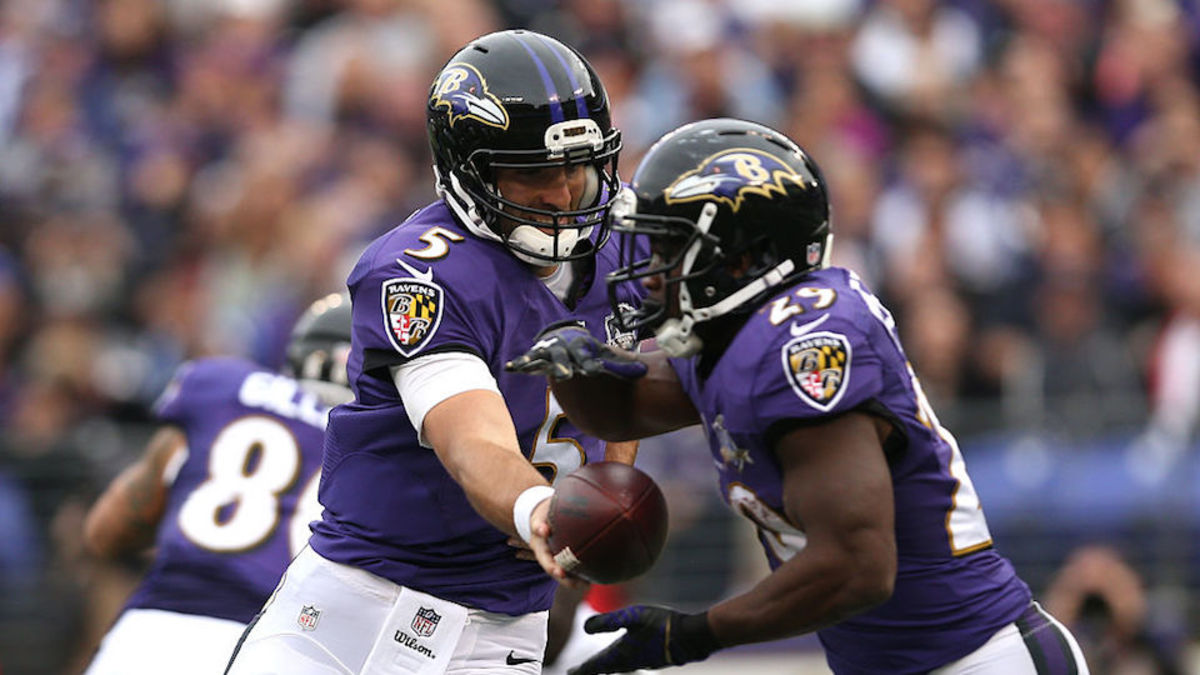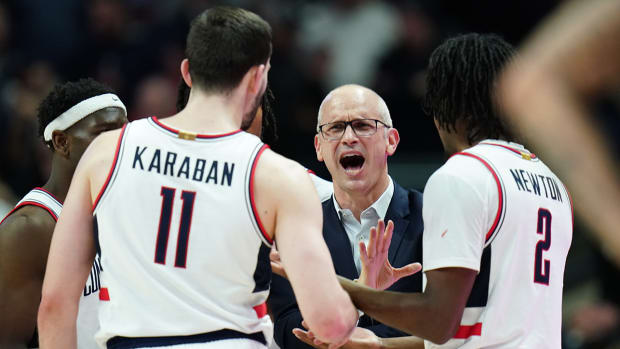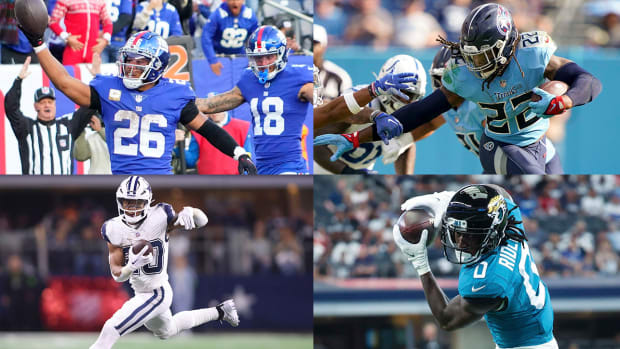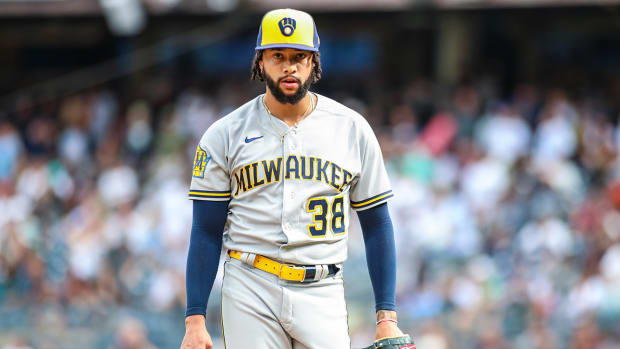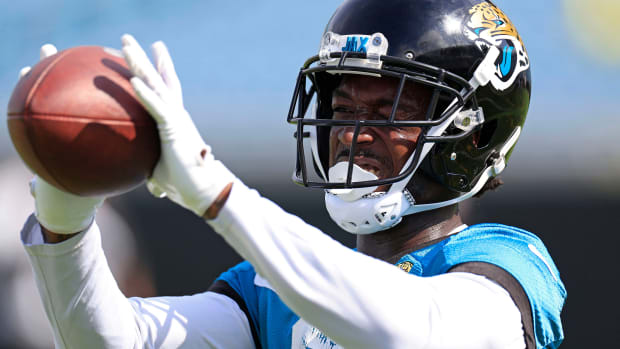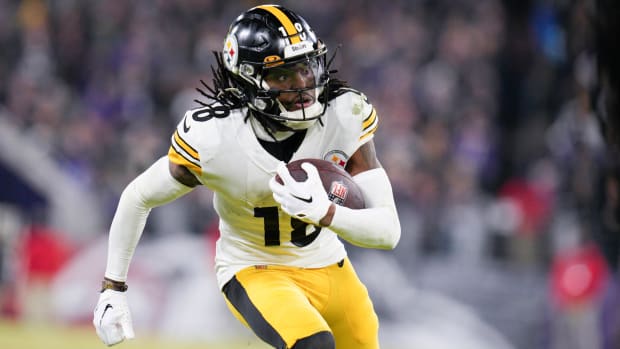Unraveling the Ravens: Who to trust on the NFL's most confusing fantasy team
Once upon a midnight dreary, while I pondered, weak and weary,
Over a quaint and curious Baltimore fantasy corps ...
There is no team more perplexing to fantasy owners this year than the Baltimore Ravens. Their QB position is stable with Joe Flacco, a paragon of averageness, but at running back, wide receiver and tight end, the Ravens’ depth chart is a jumble. There’s an interesting three-way battle at running back. The situation at wide receiver is an opaque mixture of young and old, healthy and ailing. There are four tight ends with a chance to contribute.
Injuries stretched the Ravens thin at the skill positions last year. Seemingly terrified of being left shorthanded again, the front office drafted a running back and signed a receiver and a tight end. Now, the Ravens have a nearly inscrutable mixture of one-time starters coming back from injury, replacements who inherited starting jobs in 2015 as the injuries mounted, and newcomers. As training camp opens, the Ravens are a puzzle for fantasy owners to ponder.
Let’s try to start putting the puzzle together, even if it’s impossible to finish.
To better evaluate the Ravens’ offense, we have to start with their offensive coordinator, Marc Trestman, now entering his second year with the team. Before that, he spent two years as the Bears’ head coach and de facto offensive coordinator. He’s also held coordinator jobs with the Raiders, Cardinals, 49ers and Browns, giving him 11 years of experience as an NFL play caller.
Some quick takeaways from those 11 seasons:
• Trestman’s offenses have finished in the top half of the league in total yardage seven times, and in the top half of the league in passing yardage eight times.
• Every one of Trestman’s offenses ranked in the top half of the league in pass attempts, and seven of his offenses ranked in the top 10.
• The highest finish in rushing attempts for any Trestman offense is 15th. His teams have finished out of the top 20 in rushing attempts in each of his last seven seasons as a play caller.
• Since 2006, Trestman’s offenses have run the ball on only 36.9% of their total snaps, and on 39.5% of their red-zone snaps. (Hat tip to T.J. Hernandez of 4for4.com for those numbers.) Trestman has called a higher percentage of passes over that span than pass-heavy play callers such as Sean Payton, Ken Whisenhunt, Scott Linehan and Chan Gailey.
Clearly, Trestman is a pass-happy dude.
Before we get to the positions of intrigue, let’s talk about Flacco for a moment. The eight-year veteran tore his ACL in November and was sidelined for the first time in his career. Flacco has never thrown for 4,000 yards in a season but was on pace to throw for more than 4,400 before he went down. He’s ready to go for training camp, and it’s not as if we have to worry about the injury having an effect on the lumbering Flacco’s mobility.
In an article on the offensive impact of Marc Trestman, Jeff Miller of Dynasty League Football found that quarterbacks who have played a significant number of games under Trestman scored 11.5% more fantasy points with Trestman than they did under other offensive coordinators.
• Best of the best: SI’s list of player rankings at every position
Flacco figures to derive more of his fantasy value from yardage than from touchdowns. While Trestman’s pass-heavy tendencies have often led to big passing yardage, they’ve rarely led to big TD numbers for his quarterbacks. Trestman’s offenses have averaged 21.4 TD passes per season. Five of his teams have ranked in the top 10 in TD passes. Four of his teams have ranked in the bottom 10 in that category, including a last-place finish and a 31st-place finish. Flacco averaged 21.1 TD passes over his first seven seasons and was on pace for 22 last season, so it’s hard to envision him having a big spike in his touchdown total. But Flacco could easily finish in the top 10 in passing yardage, and he’s a nice value at his low-QB2 average draft position.
Let’s move on to the other positions.
RUNNING BACKS
As noted above, Trestman’s offenses have run the ball on less than 40% of their snaps. That limits the fantasy value of the Baltimore RBs strictly in the running game, but there’s a lucrative passing-game windfall to be divided. Trestman’s running backs have caught an average of 107.1 receptions per season. His top pass-catching running backs have averaged 67.6 catches per season.
Some of Trestman’s RBs have produced massive single-season reception totals. Matt Forte averaged 88 catches in two seasons with Trestman, including 102 catches on 130 targets in 2014. Charlie Garner had 91 catches in 2002 when he and Trestman were with the Raiders. Derek Loville had 87 catches for the 49ers in 1995. (Loville never had more than 16 catches in any of his other seven years in the league.) Michael Pittman had 73 catches for the 2000 Cardinals.
In a must-read article on the fantasy-relevant tendencies of offensive coordinators, Chris Raybon of 4for4.com noted that Trestman has had a 20-touch back in 58% of his games over last three seasons—the NFL average is 37.8 —so it’s well worth trying to peg this situation
After rushing for a career-high 1,266 yards in 2014, Justin Forsett was leading the Ravens in rushing last year when he broke his forearm in the same game that Flacco tore his ACL. Forsett is considered the favorite to lead the Ravens in rushing yardage, but it seems unlikely he’ll be Trestman’s top pass-catching RB. Forsett is a rarity: an early-down back in a third-down scatback’s body. The 5-8, 195-pound Forsett actually was a third-down back earlier in his career, leading the Seattle RBs in receptions in 2009 and 2010, but has been woefully ineffective as a pass catcher in recent years. He averaged 4.9 yards per catch and 3.7 yards per targets last season, and 5.5 yards per catch and 4.3 yards per target over the last three seasons.
• Chasing the dream: Training camp’s inspiring stories
Unlike Forsett, Javorius “Buck” Allen is an able pass catcher. A 2015 fourth-round draft pick from USC, Allen spent the early part of his rookie season in a relief role before replacing the injured Forsett as the starter. Allen ranked sixth among RBs in standard scoring from Week 11 to Week 17, third in PPR scoring. He had 38 receptions over the Ravens’ last seven games and averaged 7.8 yards per catch and 5.8 yards per target for the year. He didn’t show as much as a rusher, averaging 3.8 yards and scoring one TD on 137 carries. However, Allen took the vast majority of his handoffs from quarterbacks other than Joe Flacco, which meant that opposing defenses could keep plenty of defenders in the box without fear of reprisal from Matt Schaub, Jimmy Clausen or Ryan Mallett.
Forsett’s talent as a runner can’t be overlooked. Scott Barrett of Pro Football Focus recently noted that Forsett’s career average of 4.9 yards per carry ranks only behind Jamaal Charles among active running backs with at least 600 NFL carries. But Forsett turns 31 in October, and over the last 40 years, only 21 running backs 31 or older have reached the 1,000-yard rushing mark, and only 57 have rushed for 700 or more yards.
In the 10 games Forsett played last season, he handled 60.9% of Baltimore’s rushing attempts. Let’s be optimistic and assume that rate will be the same. We’ll also be optimistic and assume the Ravens will run the same number of plays from scrimmage as last year: 1,083, which was the fifth-highest total in the league. If the Ravens run the ball on 36.9% of their offensive plays (Trestman’s percentage of run calls over the last 10 years), that’s exactly 400 runs as a team, with Forsett getting 243 of them. If he repeated his 2015 average of 4.2 yards per carry, Forsett would finish with 1,021 rushing yards. Forsett has scored TDs on 2.5% of his career carries, and if he maintains that rate over 243 attempts, he’d scored 6.1 TDs. Forsett’s fantasy owners would no doubt be satisfied with a 243-1,021-6 rushing season, even though his recent history suggests that there won’t be much receiving yardage to go with it. Of course, this assumes that he stays healthy all season, doesn’t see an age drop-off, and is able to fend off his in-house challengers.
One of those challengers is rookie Kenneth Dixon, a fourth-round pick and the wild card in the Ravens’ RB picture. Despite operating behind an offensive line that couldn’t knock a bundle of balloons off the line of scrimmage, Dixon piled up 1,537 yards from scrimmage and 26 TDs at Louisiana Tech last year. He also had a pair of 28-TD seasons and rushed for more than 1,000 yards in three of his four years.
It makes sense to project Forsett as Baltimore’s early-down back and Allen as the passing-down back, but Dixon could potentially commandeer the role of either—or both. Dixon was a TD machine at Tech, and he’s a good pass catcher who had 63 receptions over his final two college seasons.
Forsett isn’t a bad value at his current ADP of RB35, but it would be a stretch to call him a bargain. He’ll have to beat out at least two challengers to remain the early-down back, and Forsett doesn’t figure to see much action on passing downs. Allen’s ADP ranges from RB48 (FantasyPros) to RB54 (Fantasy Football Calculator). It’s an appealing price considering that Allen has the inside track to be the passing-down back and is bigger and faster than Forsett. At the very least, Allen should be a useable flex option in PPR leagues. Dixon’s ADP is in the RB42-RB49 range, where he’s a worthy swing-for-the-fences pick.
Terrance West and Lorenzo Taliaferro are likely competing for a single fourth-string roster spot. After rushing for 673 yards as a rookie with the Browns in 2014, West played two games with the Titans last season before joining the Ravens and giving Allen an occasional breather late in the year. Taliaferro is a banger who’s had trouble gathering any momentum due in part to knee and foot sprains. Trent Richardson is also on the roster, but he’s already on the physically unable to perform list after having arthroscopic knee surgery in June and is a long shot to stick. Kyle Juszczyk is a decent pass catcher as fullbacks go, but he’s a fantasy afterthought.
WIDE RECEIVERS
Steve Smith Sr. was off to a fast start last year, with 46 catches for 670 yards and three TDs in his first seven games, but a torn Achilles tendon in Week 8 ended his season. Smith had said the 2015 campaign would be his last, but he now plans to stick around for a 16th NFL season. He begins training camp on the PUP list.
One of the great competitors of the modern era, Smith has compiled career numbers that will earn him Hall of Fame consideration. Some people are therefore willing to believe that he can produce helpful fantasy numbers at age 37, less than a year after sustaining an injury from which few players ever fully recover. Smith disciples may be walking into the same sort of value trap that Victor Cruz backers stumbled into last season, when Cruz carried an ADP of WR34 but was unable to make it back onto the field less than a year after tearing his patellar tendon. Smith has an ADP of WR40, according to FantasyPros.
Smith has never been short on bluster. (“Take your a** back to Carolina,” he barked after the Ravens beat his old employer the Panthers in 2014. “Make sure you mow my lawn while you’re out there.”) Yet the loquacious veteran seems unwilling to predict a triumphant return. Smith, who needs 39 catches to reach 1,000 for his career, said during minicamp, “I may catch that in my uniform, get in my car and go home.”
All things considered, Smith’s current asking price is exorbitant.
• BELLER: Training camp battles all fantasy owners must watch
If you’re unwilling to invest in players who lack a lofty college pedigree and an extensive NFL track record, Kamar Aiken may not be for you. An undrafted free agent out of Central Florida, Aiken had cups of coffee with the Bears, Bills and Patriots early in his career, suiting up for three games in 2011-12 and none in 2013. But this late bloomer has settled in comfortably with the Ravens, playing every game over the least two seasons and recording a career-high 75 catches last year.
After Smith tore his Achilles on Nov. 1, Aiken ranked WR17 in standard scoring and WR14 in PPR scoring from Week 10 through Week 17. He caught five or more passes in each of the Ravens’ last nine games, averaging 74.8 yards per game over that stretch. For much of that run, Aiken was catching passes from the Schaub-Clausen-Mallett troika. Aiken had five catches for 90 yards against the vaunted Seattle defense in week 14, then had eight grabs for 128 yards and a TD the following week against a good Kansas City secondary.
In an article from April 2015, T.J. Hernandez of 4for4.com made some interesting observations about wide receivers in Trestman offenses. “Every primary receiver in a Trestman offense has stood at least 6-2, except for Webster Slaughter in 1989, who is 6-1,” Hernandez wrote. “Outside of Jerry Rice, who was the top target in a Trestman offense four times, the No. 1 target in a Trestman offense, on average, has been in their third year.”
Whether that height trend continued last season is open to debate. Smith, who stands 5-9, was clearly the Ravens’ No. 1 receiver while healthy. But after Smith’s injury the 6-2 Aiken took over. And though he played his final year of college football in 2010, this will be Aiken’s third season as a significant contributor, so he appears to fit the profile of a top Trestman receiver.
Aiken should get ample snaps since he’s the Ravens’ most versatile receiver, able to line up at split end, flanker or in the slot. His ADP is WR48 at FantasyPros, WR54 at Fantasy Football Calculator. He merits a strong buy recommendation at that price. And in case you haven’t read it already, this Aiken dissection by NFL.com’s Matt Harmon is worth your time.
A prominent deep-ball threat with the Steelers earlier in his career, Mike Wallace spent the last three seasons trying to fit in first with the Dolphins, then with the Vikings. He’s just two years removed from a 10-TD season with Miami, but Wallace posted the worst numbers of his career last season in Minnesota.
Flacco is among the best deep throwers in the league, and his downfield artistry could once again make Wallace a worthwhile fantasy commodity. Because he’s a home run hitter rather than a volume receiver, Wallace is a better play in best-ball leagues than in conventional leagues, likely to put up big numbers in a handful of games and be a virtual no-show in others. With an ADP in the WR59-WR63 range, Wallace can be had at flea market prices these days. Some will see that as a bargain price; others will debate whether it’s worth the opportunity cost to take Wallace over some other end-of-the-draft flyer.
Wallace’s value is tied closely to Breshad Perriman, another fleet-footed field stretcher. Poor Perriman. Already cursed with the hairline of a 50-year-old, the young receiver has been plagued by knee injuries since joining the Ravens. The 26th overall pick of the 2015 draft, Perriman partially tore his right PCL in the first full-squad practice of last year’s training camp. He now has a partially torn ACL in his right knee, but rather than having season-ending surgery, he had an arthroscopic procedure and received a stem-cell injection. Like Smith, Perriman begins training camp on the PUP list, and it’s unclear when he’ll return to action.
• BELLER: Gordon’s back for Browns, but can fantasy owners trust him?
If there were no chance Perriman would return this season, Wallace’s ADP might jump by several rounds. But if Perriman, who pairs a 6-2 frame with sub-4.3 speed, can get back to something close to full capacity, he has the potential to marginalize Wallace.
Coming out of the University of Miami (Fla.), Perriman was considered a somewhat raw prospect with questionable hands. His injuries have robbed him of much-needed reps, and since he’s probably going to be treated with kid gloves in training camp and the preseason, this might not be the year to bet on him, even at a gambler-friendly ADP of around WR60.
As for the others, rookie Chris Moore, a fourth-round pick out of Cincinnati, should stick on the roster but could be buried on the depth chart behind fellow vertical threats Wallace and Perriman. Jeremy Butler had 31 catches for Baltimore last season largely because of all the injuries and might be a long shot to make the roster. Also facing a battle to make the final 53 are the diminutive Michael Campanaro and former Seahawks Super Bowl hero Chris Matthews. Rookie Keenan Reynolds is likely to stick but will probably be relegated to special teams work.
TIGHT ENDS
Baltimore TEs combined for 81 catches last season. It’s tempting to assume that number will climb, since Martellus Bennett alone caught 155 balls during Trestman’s two years in Chicago. But the only other Trestman tight end to catch more than 40 passes in a season was Brent Jones, who had 60 receptions in 1995. Granted, Trestman worked with some target-monster WRs in his early offensive coordinator gigs, including Jerry Rice and Tim Brown, and Trestman’s TEs included such non-luminaries as Doug Jolley and Terry Hardy. Still, it’s best not to assume that Trestman’s pass-happiness will automatically extend to the Ravens’ TEs.
After getting a two-year, $7 million deal in free agency, 35-year-old Ben Watson is expected to start. He’s coming off a career-best 74-catch season with the Saints after surpassing the 50-catch mark only once in 11 previous seasons. Watson was targeted 16 times in the red zone and turned five of those targets into TDs, helping him tie a career-high with six TDs for the year.
New Orleans has long been Shangri-La for tight ends, and Watson had been little more than a peripheral contributor throughout his career, so hopes of a similarly productive season seem far-fetched, particularly when there are younger competitors pressing for playing time behind him. Watson’s ADP of 24 is in line with his low-TE2 outlook.
• How will Jaguars’ rise impact Blake Bortles in fantasy?
Known primarily as a blocker, Crockett Gillmore was surprisingly productive as a pass catcher last year, hauling in 33 passes in 10 games before a back injury ended his season. The 24-year-old Gillmore also required offseason shoulder surgery, but he’s been cleared for individual drills in training camp. Averaging just a shade under 9.0 yards per target, Gillmore ranked among the elite tight ends in that category last year. He’d be a far more interesting fantasy prospect were it not for his health issues and all the positional competition. Gillmore probably isn’t draftable in most leagues but could become an attractive waive wire option at some point.
Rookie tight ends rarely offer any sort of meaningful fantasy production, and Maxx Williams was no exception. A second-round pick out of Minnesota, Williams had only 32 catches for 268 yards last year despite making seven starts and playing nearly half off the Ravens’ offensive snaps. It’s hard to envision a major leap for him this season unless injuries thin the herd at tight end.
Seemingly destined for early retirement after two serious hip injuries, Dennis Pitta has been cleared for training camp and could be a surprise contributor after missing all of 2015. Pitta had a nice year in 2012, with 61 catches for 669 yards and seven TDs, but that was his only noteworthy season, he’s 31 now, and his medical history is alarming. As with Gillmore and Williams, Pitta is undraftable in the vast majority of fantasy leagues but still worth tracking.
































